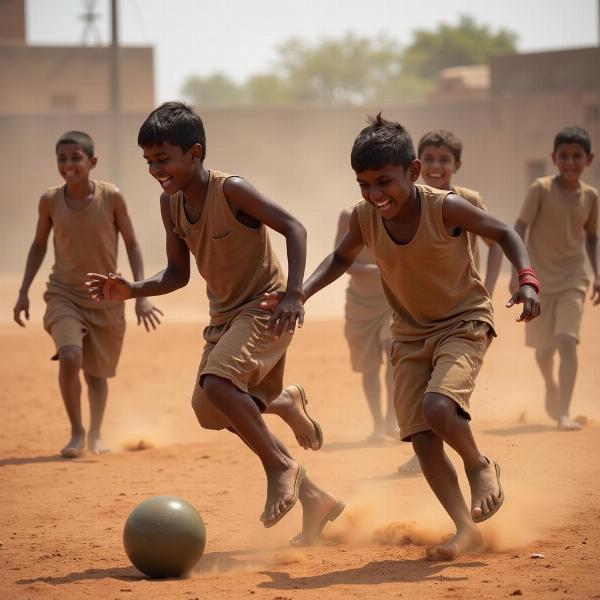Knucklebones, a simple game played across cultures for millennia, holds a special place in Indian history and tradition. Understanding the knucklebones meaning in Hindi reveals more than just the name of a game; it unveils a connection to ancient customs, linguistic nuances, and evolving cultural significance. This article explores the various facets of knucklebones in India, from its historical roots to its modern interpretations.
Unraveling the Term “Knucklebones” in Hindi
The most common Hindi term for knucklebones is “gilli danda” (गिल्ली डंडा). While “gilli” refers to the small bone or wooden piece used as the target, “danda” represents the larger stick used to strike it. This terminology clearly depicts the game’s physical components and mechanics. However, other regional variations exist, highlighting the game’s widespread popularity and adaptation across diverse linguistic landscapes within India. For instance, in some parts of India, the game is also known as “itti daaku” or simply “gutti.”
A Glimpse into History: Knucklebones in Ancient India
Evidence suggests that games resembling knucklebones have existed in India since ancient times. Archaeological findings and historical texts allude to similar games played with small objects and sticks, suggesting a long-standing tradition. These games were not merely pastimes but often carried social and ritualistic significance, sometimes even serving as tools for divination. The simplicity of the game allowed it to transcend social barriers, making it a popular activity across various strata of society.
From Past to Present: Knucklebones in Modern India
Despite the influx of modern games and technology, gilli danda retains its charm, particularly in rural India. It’s a common sight to see children engrossed in the game, their laughter echoing through the streets and fields. This continued popularity speaks to the game’s inherent appeal and its ability to connect generations.
 Children Playing Gilli Danda
Children Playing Gilli Danda
Beyond the Game: Cultural Significance of Knucklebones
The cultural significance of knucklebones extends beyond the game itself. It represents a connection to a simpler time, a shared experience that binds communities. The game also embodies values of skill, strategy, and healthy competition. Moreover, the use of natural materials like wood and bone reflects a harmony with nature, a characteristic deeply ingrained in Indian culture.
Knucklebones in Literature and Language
The presence of knucklebones in Indian literature and language further underscores its cultural relevance. References to similar games can be found in ancient texts and folklore, often used as metaphors for life’s challenges and triumphs. The continued use of regional variations of the name highlights the game’s enduring presence in the linguistic landscape of India.
Conclusion: Knucklebones – More than Just a Game
Understanding the knucklebones meaning in Hindi reveals a rich tapestry of history, culture, and language. From its ancient roots to its modern-day iterations, gilli danda remains a beloved pastime, connecting generations and embodying the enduring spirit of Indian tradition. It’s a testament to the power of simple games to transcend time and continue to hold a special place in the hearts of many.
FAQ
- What is the most common Hindi word for knucklebones? Gilli danda (गिल्ली डंडा).
- What are the two main components of the game? The gilli (small bone or wood piece) and the danda (larger stick).
- Where is gilli danda most commonly played today? Primarily in rural areas of India.
- Does gilli danda have any cultural significance? Yes, it symbolizes a connection to tradition, skill, and community.
- Are there other names for gilli danda in India? Yes, variations like “itti daaku” and “gutti” exist in different regions.
- Is gilli danda mentioned in Indian literature? References to similar games appear in ancient texts and folklore.
- What materials are traditionally used to make the gilli and danda? Wood and bone.
Meaning-Hindi.in: Your Trusted Partner for Hindi Translation
Meaning-Hindi.in is a leading provider of professional Hindi translation services, catering to a diverse range of needs, from business and legal documents to technical manuals and website localization. Our team of expert linguists possesses a deep understanding of Hindi grammar, nuances, and cultural context, ensuring accurate and culturally sensitive translations. Whether you require translation of business documents, legal contracts, technical manuals, educational materials, or website content, our team is equipped to handle projects of any size and complexity. Contact us today to discuss your translation needs! Email: [email protected], Phone: +91 11-4502-7584.